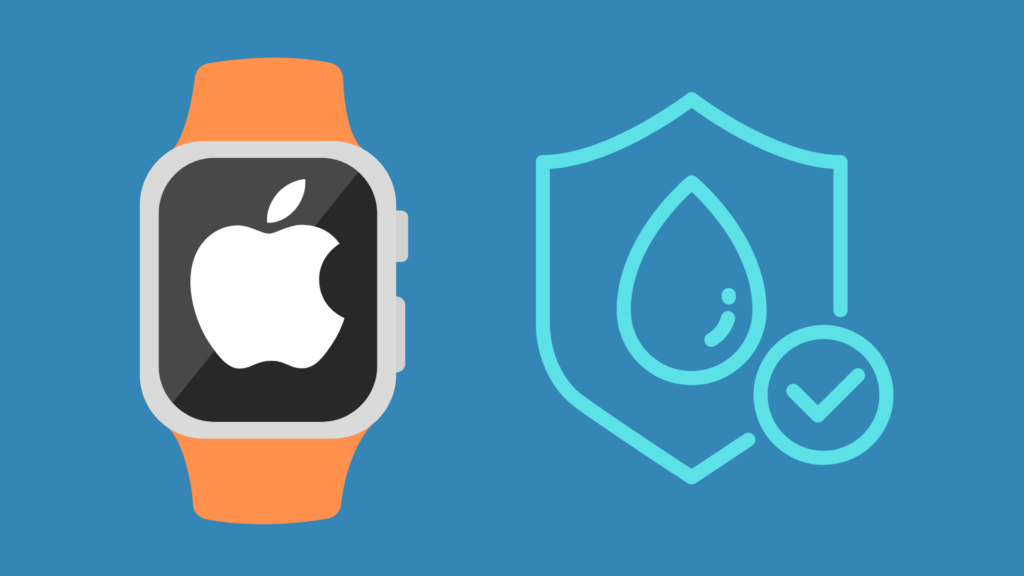Are Apple Watches Waterproof?

Apple Watches can do quite a lot for your life and productivity, so it makes sense that you would want to keep it with you at all times of the day. However, there are times when you may feel unsure about whether it is the best idea to do that. For example, a rainy day can be a big problem for some electronics, and going swimming is simply dead in the water (no pun intended) for many devices. Which causes people to ask, are Apple Watches waterproof?
There are claims that the Apple Watch is waterproof, but that is entirely situational on which Apple Watch you own (and has heavy caveats). The 1st generation Apple Watch and Apple Watch Series 1 are splash and water-resistant, but it could cause damage to them if you submerge either in water. The Apple Watch Series 2 and later models have increased defense from water damage, but it should be noted that no electronic should be understood to be 100 percent waterproof.
But how far can the Apple Watch’s waterproofing go? And is it particularly good at resisting water?
Are Apple Watches Waterproof?
As mentioned in the beginning of the article, figuring out whether your Apple Watch is just water-resistant or is actually waterproof will ultimately depend on the model of Apple Watch you own, and understand that being ‘waterproof’ is not a 100 percent guarantee.
The 1st generation Apple Watch and Apple Watch Series 1 are resistant to both water and splashes, while the Apple Watch Series 2 (and anything newer than it) are waterproof. This means that they can be worn while swimming in shallow water, such as the ocean or the pool.
However, you should still be cautious about the environment you are in. It would be something of a disappointment if no Apple Watch models were able to handle being worn while swimming, as Apple has come to emphasize the value of it as a health and fitness device would make it disappointing if you couldn’t wear it while engaging in a quality (and fun) exercise.
While the Series 2 (and later) are designed to be able to handle shallow water, if you go too deep in the water, that may cause the Apple Watch to become damaged, particularly causing damage that may cause the mechanisms intended to protect the watch from damage.
This is because the deeper you go underwater, the more pressure you (and your Apple Watch) experience. The Apple Watch can only handle water up to 50 meters (164 feet) in depth. With added pressure, different aspects of the Apple Watch will be unable to handle it and break. There are other things that can cause damage to worsen, however.
In addition to the depth of water, you must also be concerned about the strength of the water. For example, if you are water-skiing, you would be strongly recommended avoiding wearing your Apple Watch at the same time.
Additionally, if you go for a swim in the ocean (or any water that may not be the freshest), your Apple Watch should be fine, but you should still rinse it off once you are able to do so with fresh water.
Do Apple Watches become less waterproof or resistant over time?
As we discussed above, different circumstances may cause your Apple Watch to become damaged or at least be less able to resist damage. However, there are other things that may cause your Apple Watch to be less waterproof and water-resistant.
For example, if you drop your Apple Watch, or bang it against a surface, this could cause your Apple Watch to be able to resist water damage less. The worst part is that the Apple Watch cannot be rechecked or resealed to improve water resistance.
Can an Apple Watch be damaged from being splashed, exposed to sweat, or excess humidity?
If you are particularly sweaty (or just work out pretty hard), you may be worried that even with the water resistance, the sweat from your workout or the heat may be enough to overcome that. Thankfully, unless there is some level of defect that causes your Apple Watch to be damaged this way, you should not have to worry about sweat causing your Apple Watch to become damaged. It is not 100 percent guaranteed (again, defects), but it’s so unlikely that you can put it out of your mind.
However, as far as humidity goes, things are a lot different there. While some exposure to humidity is not the end of the world, you should still make an effort to avoid exposing it to too-humid of an environment for too long. This is also true of exposing it to extreme temperatures for too long. Your Apple Watch is designed to be typically able to handle temperatures between 32F and 95F (0C and 35C respectively). Furthermore, be mindful of allowing your Apple Watch to undergo sudden temperature changing. Of course, it is not necessarily going to be doable all the time, but again, try to avoid that from happening the best you can.
Does my Apple Watch warranty cover damage from being submerged in or otherwise exposed to water?
If your Apple Watch becomes damaged due to exposure to water, whether you will be able to get it covered is a complicated one. For example, if you have a 1st generation Apple Watch or Apple Watch Series 1, damage caused by submerging the Apple Watch would not be able to be covered by a warranty.
This is because it was never advertised as being capable of being submerged, merely that it is resistant to splashes and sweat. However, if the Apple Watch is Series 2 or later, this is a completely different story.
If your Apple Watch Series 2 or later was damaged due to being submerged, there are different possibilities at play here. For one, if it has been quite a while since you originally purchased your Apple Watch, there is a decent likelihood that the damage was simply due to normal wear and tear over the years. This is moot for this point, as it would be out of warranty by now anyway.
However, if it is doing this and is still covered by warranty, this means that there was a manufacturer’s defect that caused it to happen, or you did such serious and/or persistent damage to it over a short period of time. It may also be due to using it in conditions that are not advised by Apple, such as going below a certain level of depth.
If it is due to user negligence, you would not be able to get it covered under Apple’s standard warranty. The only way it would be covered is if a defect caused it to be vulnerable to damage caused by submersion.
Can I accidentally activate my Apple Watch while in the water?
We’re sure that we have all had at least one time when our smartwatch or phone activated when we didn’t want it to. Thus, it should come as no surprise that many are concerned about your Apple Watch accidentally waking up while you are swimming with it on. Thankfully, there is actually a system meant to keep your watch asleep while you’re out for a swim. This is called the Water Lock, which basically prevents your smartwatch from waking up from your arm movements in the water.
Can I get water out of my Apple Watch?
There are multiple ways that water can get into your Apple Watch, one of which is water getting into your speakers. While this may seem dangerous, the good news is that Apple actually has a method by which to eject water from the speaker. To do it, you would have to turn the Digital Watch on the side of the watch until it says Unlocked, which takes it out of the Water Lock mode. After you finish unlocking it, the Apple Watch will begin to play tones designed to excise the water from the speaker. It is advised that you position the watch so that the speaker is pointed down while it is in this mode.
How does the level of water resistance and proofing in Apple Watches compare to similar products?
While the Apple Watches are no slouches as far as water resistance and proofing goes, that does not necessarily mean that they are good in comparison to other devices like it. There are two things that need to be considered: are Apple Watches particularly well-made for waterproofing or resistance compared to other Apple devices, and how do they compare to other watches like it?
For this, we looked at the Samsung Galaxy Watch, which actually has a similar efficacy with respect to water protection (at least, depending on the model of Galaxy Watch you own). Like the Apple Watch, the Samsung Galaxy Watch can handle up to 50 meters of depth (164 feet). Additionally, Samsung Galaxy Watch also has a Water Lock function, as well as the ability to eject water from the speaker.





